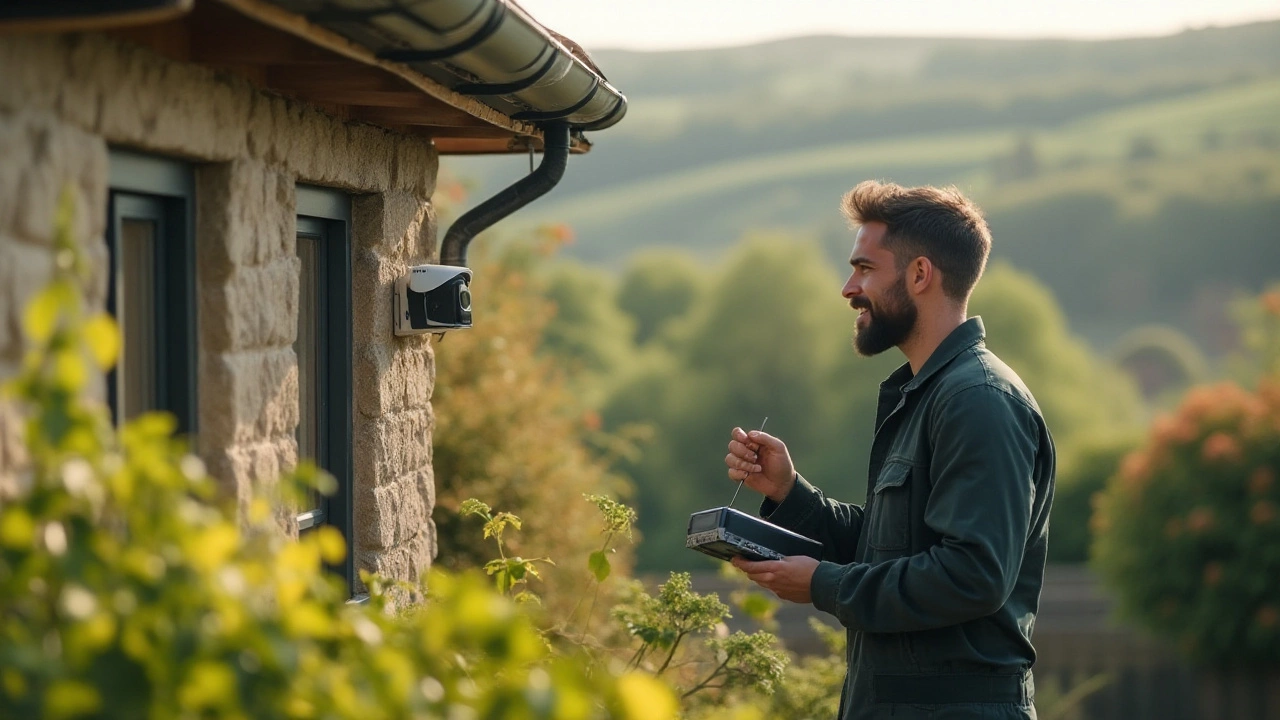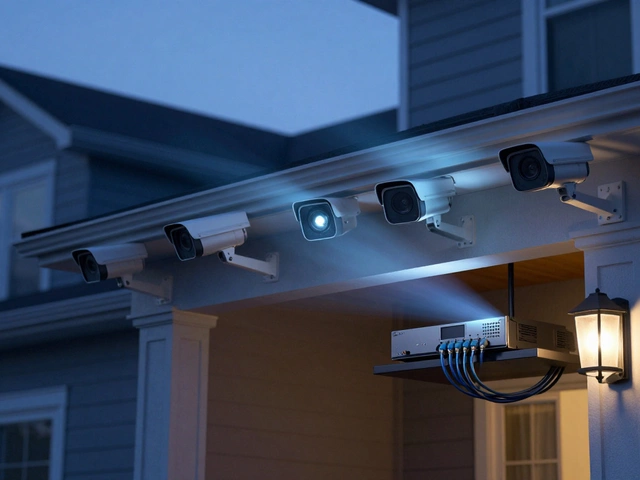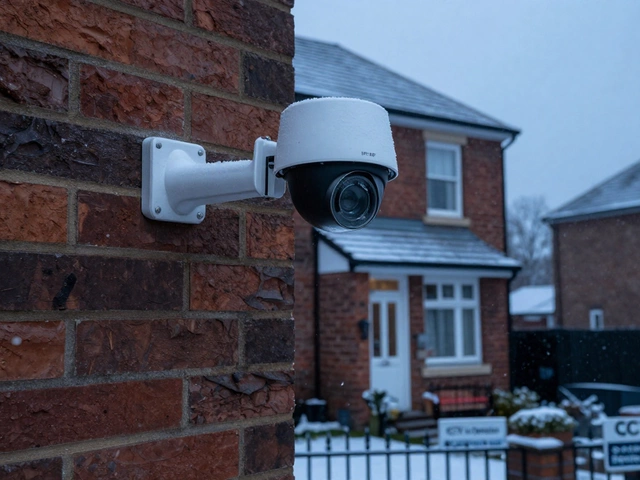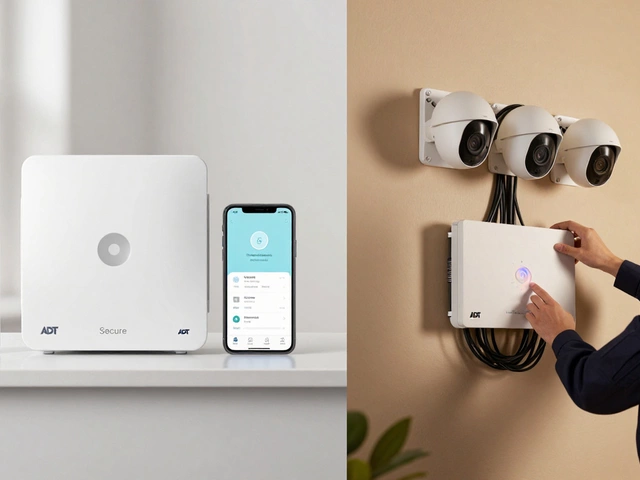We're all quick to connect technology to the web, but there's something to be said about the security systems that operate independently of the internet. Especially when it comes to CCTV operations where privacy is a consideration, understanding how these systems work offline can be a game changer. You might think internet is a given for modern surveillance, but that's not always the case.
Here, we’ll explore how traditional security setups manage to keep an eye on things without the digital tether. From how they store video footage to the circumstances where they stand out, offline CCTV systems are like the secret weapons of modern security installations. Whether you're looking to cut down on costs or ensure unwavering performance despite technical hiccups, realizing the potential of offline CCTV might save you a headache or two.
- Understanding Offline CCTV Functionality
- Components of a Non-Internet CCTV System
- Benefits and Limitations of Off-Grid CCTV
- Cost Factors in Installing Offline CCTV
- Enhancing Security with Offline Systems
Understanding Offline CCTV Functionality
When you're discussing the backbone of security systems that operate without internet connectivity, it starts with understanding the core components that make these systems tick without the assistance of online resources. Offline CCTV installation systems rely heavily on localized hardware to perform all necessary functions. The primary component in such scenarios often includes a DVR (Digital Video Recorder) or an NVR (Network Video Recorder), which handles the recording and storage of video footage. These devices are designed to work independently, ensuring that your security systems remain operational even in areas where internet access may be scarce or unreliable.
The heart of an offline CCTV system lies in its wiring and data handling. The cameras themselves might be IP cameras, which typically require a network, but in a non-connected setup, they operate through direct connections to the recording devices. This setup often involves coaxial cables for analog systems or Ethernet cabling for digital ones, carrying both power and data. The beauty of an offline system is its simplicity and the reassurance it provides against external interruptions or potential security breaches that could occur over the internet. The data captured by CCTV cameras is transported directly to the DVR or NVR, where it's stored on local hard drives.
Many offline systems benefit from ample storage capacity, allowing for weeks or even months' worth of continuous footage. This is crucial when ensuring a secure environment, as it offers a historical record in case you need to review past events. Manufacturers continue to innovate by adding user-friendly interfaces, making it easy to navigate through stored footage on DVRs, without needing an internet connection. Advances in compression technology, like H.265+, have improved the efficiency of video files, ensuring sharper quality images are stored using less space.
However, modern offline systems are not entirely without digital conveniences. Though they don't require an internet connection for primary functions, these systems can connect briefly to configure software updates or manage settings if the feature is desired. It's a misunderstanding to think offline means outdated or overly basic. There’s often the option to expand functions with internet connectivity, like adding remote monitoring capabilities or receiving alerts. Yet, many users opt to operate them offline entirely to take advantage of heightened privacy and the reliability that comes with non-cloud-based storage.
"The fear of data hacking or leaks is significantly minimized in entirely offline setups. When data does not traverse online pathways, the risk of interception is inherently reduced, not requiring encryption or complex networking protocols to safeguard it." - Security Systems Journal, 2024
Offline systems are versatile and adapt well to various environments. Whether utilized for residential homes, commercial spaces, or rural properties, these systems provide steadfast surveillance without the underlying concern for bandwidth limitations or network downtimes. These attributes make them particularly popular in locales with frequently intermittent internet connectivity.
Despite the simplicity of their operation, the tech behind offline security cameras continues to evolve, bridging the gap between low-tech procedures and high-tech outcomes. As technology for non-Internet-dependant systems advances, users continue to rely on them for one crucial aspect – assurance. You can literally be off the grid and still maintain vigilant oversight thanks to these ingenious systems.
Components of a Non-Internet CCTV System
When considering a CCTV installation without the reliance on the internet, understanding the core components that make it tick is essential. These systems are like the classic toys of security surveillance, robust and often more reliable when it comes to delivering consistent performance regardless of connectivity outages. Essentially, the heart of these systems is the Digital Video Recorder (DVR) or Network Video Recorder (NVR), which is tasked with storing video inputs from cameras onto a physical drive. This can be seen as the cornerstone of a well-devised security system, offering a reliable means of video storage without needing to be constantly online.
DVRs in a non-internet setup typically connect directly to the cameras via coaxial cables, capturing both video and, in some models, audio. This traditional method ensures that the footage is continuously recorded on a local storage device, such as a hard disk drive, which is generally located near the DVR for easy access. This sort of local storage mechanism is crucial in areas where online infrastructure may be lacking or unreliable. It’s about sticking to the fundamentals, relying on cables and secure cases housing the necessary hardware.
Another vital component of these systems is, of course, the cameras themselves. Typically, closed-circuit cameras used in non-internet systems are not IP-based as those commonly used in network-dependent models. Instead, they rely on analog technology, which is not only cost-effective but also far less susceptible to cyber interference. What’s truly fascinating is that even in an era brimming with digital advancements, these analog counterparts offer sterling performance, making them a compelling choice for those seeking robust security systems without extra tech frills. Over 70% of small to medium enterprises prefer analog solutions over digital due to their affordability and ease of maintenance.
Let’s not overlook the monitor. In offline setups, live feeds from cameras are typically displayed on monitors physically connected to the DVR. This setup allows security personnel to view real-time or recorded video feeds without the need for an internet connection. While mobility is often limited to the control room or wherever these monitors are placed, this configuration provides direct access to areas being monitored, which is critical for static security posts.
Addressing the need for power supply, a non-internet CCTV must be strategically installed to ensure all components are within reachable distances from appropriate power sources. Power adapters and uninterrupted power supply (UPS) systems are commonly used to maintain functionality during electricity fluctuations or outages. Careful planning of power distribution is essential; it isn’t just about plugging in and pressing record. The energy source reliability can ultimately determine the efficacy of these systems.
According to Robert Grimes, a security analyst and a contributor to Security Systems News, "A well-structured, non-internet CCTV setup is a simple yet powerful solution that balances privacy and functionality effectively, making it a preferred choice for many looking for dependable surveillance."
In essence, having a non-internet based camera system allows you to hold onto the fundamentals of security technology. While the convenience and accessibility of online systems are undeniably tempting, the value of a solid, offline security system should not be underestimated. They offer a reliable alternative, keeping an eye on things steadily amidst the unpredictable nature of network-dependent systems.

Benefits and Limitations of Off-Grid CCTV
In the realm of surveillance and security, the notion of not having data flying over the web brings a breath of fresh air for many seeking privacy. With off-grid CCTV systems, there's robust security minus the risk of cyber threats. Potential hackers have a much tougher time when videos and data aren’t streaming online – a significant point for those wary of data breaches. Offline systems often tend to have more stable operations since they aren't affected by internet outages or the all-too-common bandwidth limitations. This means reliability, particularly in areas where consistent Wi-Fi connectivity is still a distant dream.
While these cameras can efficiently monitor and record what's happening on your property, they also come with the convenience of plug-and-play simplicity. Such systems can be easier to install as there's no need to run network cables or worry about configuring network settings and firewalls. Ease of installation can directly translate to cost-saving in some cases, cutting down the CCTV installation cost significantly over time. But no good thing is without its drawbacks, and offline systems sometimes struggle with their limited access to remote viewing. Without internet connectivity, you miss the convenience of accessing live feeds on your smartphone or computer when away from the location.
That being said, let’s not overlook the storage aspect of offline systems. Video storage is often localized, meaning you’ll need sufficient storage devices like DVRs or NVRs. Consider your storage needs carefully, especially if you plan on recording and saving data extensively. Remember, hard drives can fill up fast, especially with high-definition video recordings, necessitating additional investments as data accumulates. Similarly, off-grid systems generally lack the ability to send motion alerts or notifications without internet, which is a downside for someone seeking instant updates. Yet, not everyone requires immediate alerts, and for those, this limitation may be a mere blip on an otherwise clear radar.
According to a recent survey by the Security Industry Association, 67% of security experts feel that offline systems offer a safer alternative to internet-connected ones when it comes to data privacy and protection.
To truly appreciate what offline security cameras bring to the table, you need to weigh their strengths against what you might have to compromise. Yes, they may lack the glitzy features of online systems, but for many, the unparalleled peace of mind they provide is worth its weight in gold. Ultimately, whether you choose an off-grid system depends on what you value more: cutting-edge features or rock-solid safety. If you inhabit areas plagued with patchy or expensive internet service, choosing an non-internet CCTV system might just be the strategic move your home or business security plan needs.
Cost Factors in Installing Offline CCTV
Deciding to install CCTV systems that function independently of the internet can be a strategic choice, particularly in areas where reliable connectivity is an issue or where privacy is a paramount concern. But what are the factors to consider when it comes to cost? The first critical aspect is the type of equipment you'll need. Unlike their cloud-connected brethren, offline CCTV systems rely heavily on local hardware, such as DVRs (Digital Video Recorders) or NVRs (Network Video Recorders), to store footage. The price of these devices can vary significantly depending on their capacity — a high-capacity DVR that holds weeks of footage might set you back more than a basic model with a smaller hard drive.
Then there is the matter of the cameras themselves. While many opt for high-definition options for clearer image quality, such models tend to be pricier. A balance needs to be struck between resolution and budget, keeping in mind the specific needs of each surveillance scenario. The environment plays a big role too – if cameras are to be installed outdoors, they must have weather-resistant features, which can increase costs. Next, installation requires thoughtful consideration. Professional installation ensures that systems are configured correctly, with cables and devices securely placed to optimize coverage, but it can add to the initial expenses. DIY solutions exist, and though potentially cheaper, they generally demand a degree of technical know-how that not everyone possesses.
Maintenance and Future-Proofing
In estimating the costs, one must not overlook maintenance. Analog systems, though reliable, may necessitate periodic checks and updates that can incur additional spending. As technology evolves, staying up-to-date might mean upgrading equipment periodically to maintain effectiveness. Ensuring compatibility with future technologies or expanding a system later can also add layers to the expense. Insurance considerations can also come into play. Some policies may offer reduced premiums for homes or businesses with security installations, but terms vary widely and require careful review. An additional yet often forgotten cost factor is energy consumption. Although surveillance cameras are not notably power-hungry, running multiple units continuously adds up on the energy bill. Some systems offer energy-efficient models, which although more expensive upfront, could reduce operating costs over time.As the wise Eleanor Roosevelt once noted, "The future belongs to those who believe in the beauty of their dreams," and investing in a non-internet reliant security system can be a step toward a secure future, maximizing both safety and privacy in one’s environment. Navigating the initial costs of installation can be daunting, but with a thorough understanding and careful planning, the rewards of having a resilient security system that operates effectively offline are within reach. Such a system can certainly evolve with your needs, offering peace of mind that your premises are under watch even when the digital world might falter.
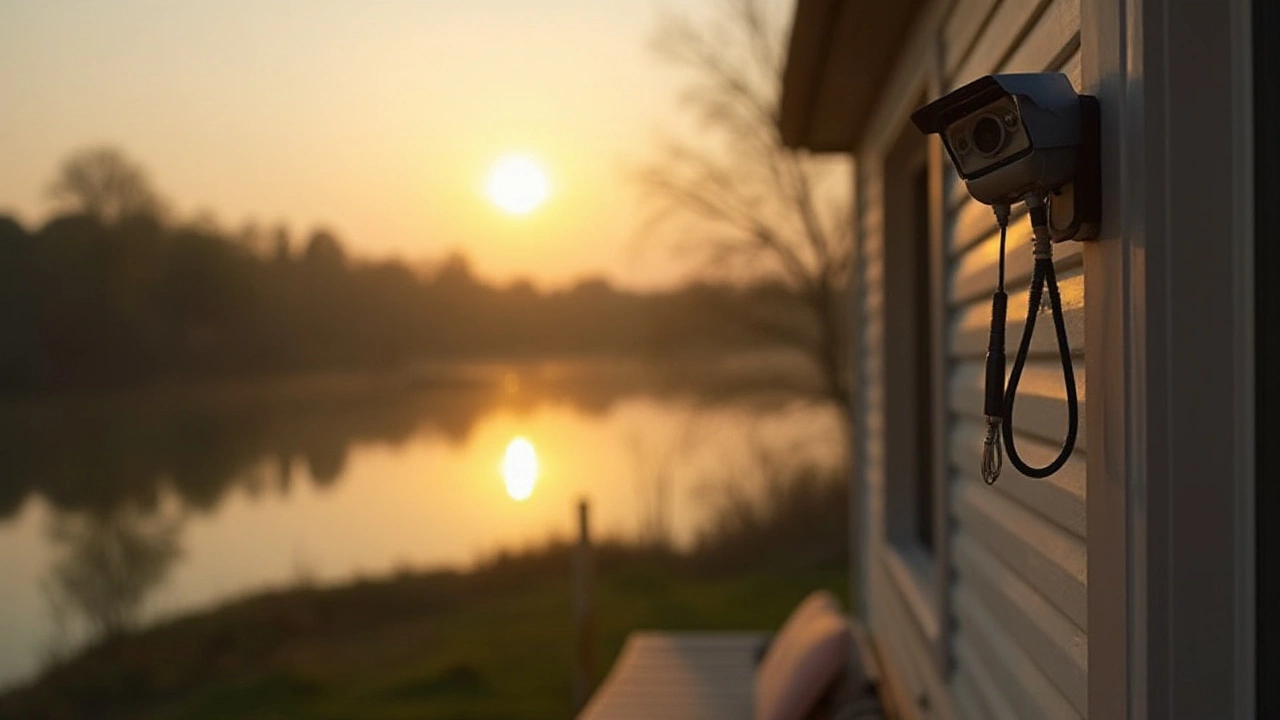
Enhancing Security with Offline Systems
In a digital age where connectivity is often presumed, offline CCTV systems offer an unexpected robust alternative for those seeking security systems without reliance on the internet. These systems are not only appealing for locations with fluctuating or unavailable internet access, but they also provide a layer of privacy and control that can be elusive in an always-online world. When enhancing security, it's crucial to assess how offline systems can be tweaked and optimized to meet specific surveillance needs.
Unlocking the potential of offline systems starts with understanding the unique features they offer. While they might not boast the seamless remote access of internet-linked systems, they ensure uninterrupted recording thanks to devices like DVRs (Digital Video Recorders) and NVRs (Network Video Recorders). Such systems utilize closed-circuit television to keep your property monitored without needing the web. This is critical when considering data protection; with no internet, there's a reduced risk of hacking or unauthorized access, providing peace of mind for privacy-focused individuals.
Offline systems often thrive due to their reliable components. At the hardware heart, choosing high-quality cables and connectors can enhance footage clarity. Regular maintenance, such as cleaning lenses and checking camera angles, ensures that no detail is overlooked. For lighting, thermal imaging cameras can be mounted to bolster monitoring capabilities in complete darkness, proving invaluable where typical lighting solutions fail.
It's also about tailored configuration. Setting up motion detection alerts and specifying recording schedules can maximize system efficiency. Integrating an alarm system to your offline security cameras creates a proactive approach to security, notifying you of disturbances without a data connection. Implementing strategic camera placements covers more ground and limits blind spots, providing comprehensive surveillance coverage.
Despite lacking remote access features, these systems can be surprisingly adaptive. Look to standalone screen options for on-site monitoring or connect directly to local network displays when reviews and queries arise. Devising a systematic check and upkeep schedule will keep these optical guardians in top form. Security specialists often recommend routine drills or checks to verify the system's readiness and recording ability.
The Security Industry Association mentions, "Privacy concerns can make offline systems an attractive option for today’s security landscapes."
Cost considerations should not be dismissed, either. While you might save on data fees, investing in robust hardware is wise. Focus on sourcing materials that ensure high durability and reliability. Prioritizing, like motion sensors with robust battery lives to complement your offline CCTV, effectively widens the net against potential threats without unnecessary expenditure.
In essence, employing offline CCTV systems might mean a little more forethought but once set, these systems rarely need constant attention. They're like silent sentinels, ensuring that the sanctity of monitored spaces is preserved. And while the digital wave seems escalating, the merit of offline tools remains undiminished. Thoughtful implementation ensures that this approach can be as sophisticated and reliable as its internet-reliant counterparts.

